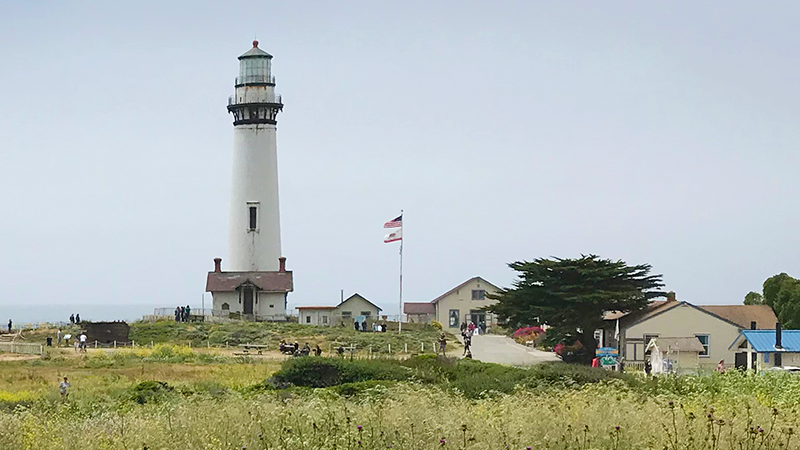
As we have traveled up and down the California coast, we have made time to visit every lighthouse nearby, including Old Point Loma Lighthouse, Point Arena Light Station, Point Bonita Lighthouse, Point Pinos Lighthouse, Battery Point Lighthouse, and Point Cabrillo Light Station. So when we planned a family camping trip with my parents in Half Moon Bay, we planned to also visit nearby Point Montara Lighthouse and the Pigeon Point Light Station State Historic Park.
Listed on the National Register Of Historic Places, the 115 foot tall Pigeon Point Lighthouse is one of the tallest lighthouses in America.
Sitting high atop a windy bluff, 50 miles south of San Francisco, on the central California coast, the Pigeon Point Light Station has been guiding mariners since 1872 when whalers and Gold Rush era clipper ships fought gales, stiff seas, jagged coastal rocks, and unforgiving fog.
Today Pigeon Point Light Station State Historic Park is a hostel, but it is still open to the public. While the dilapidated, crumbling lighthouse is closed and fenced off, you can:
- Go inside the Fog Signal Building to view the original first order Fresnel Lens and historic exhibits and displays.
- Step in the small Oil Storage Building to see historic photos of the lighthouse.
- Visit the Carpenter Shop to browse the park store.
- Walk along the boardwalk to an observation platform to watch elephant seals and whales during the whale migration and take in the spectacular view of the Pacific Ocean.
- Head down to the beach to play in the surf with your family.
About Pigeon Point Light Station
Pigeon Point’s original name, Whale Point, was inspired by the gray whales that migrate past the point. California’s Gold Rush brought many ships to these perilous waters, including the Carrier Pigeon, a state of the art, 175 foot clipper, that on its maiden voyage in 1853, ran into the fog-blanketed rocks just 500 feet off Whale Point. Eventually, the Carrier Pigeon which had been valued at $54,000 was sold, where she lay for only $1,500. The Whale Point was then renamed to Pigeon Point to honor the ship.
Between 1865 and 1868, three other shipwrecks affirmed the danger of this foggy location and in 1872, a Lighthouse was built with a light and fog signal that has guided mariners for more than a century.
Pigeon Point Lighthouse used a five-wick lard oil lamp and first-order Fresnel lens comprised of 1,008 prisms. First lit in 1872, the lens stands 16 feet tall and 6 feet in diameter. It weighs 2,000 pounds and the light reaches up to 24 miles. Although the original Fresnel lens is no longer in use and on display in the Fog Signal building, the lighthouse is still an active U.S. Coast Guard aid to navigation using a Vega Marine Rotating Beacon.
Know Before You Go
- Pigeon Point Light Station State Historic Park is located at 210 Pigeon Point Road, Pescadero, California 94060 just off Highway One between Half Moon Bay and Santa Cruz.
- The Lighthouse is closed to the public and the California State Parks Foundation is raising funds to restore and reopen the Pigeon Point Light Tower to the public. You can however go inside the Fog Signal Building to view the original first order Fresnel Lens and historic exhibits and displays. You can also go inside the small Oil Storage Building to see historic photos of the lighthouse and the Carpenter Shop to visit the park store.
- Just north of Pigeon Point, there is a great spot to go tidepooling at low tide. Just south, a small public beach is located 100 yards from the main parking lot.
- Admission and parking are free.
- The day-use grounds are open from 8:00 am to sunset.
- The Visitor Center is open from 10:00 am to 4:00 pm everyday from June to August, and only Thursdays through Mondays from September to May.
- The Park Store is open Tuesday-Thursday from 10:00 am to 4:00 pm and Friday-Monday from 10:00 am to 6:00 pm from June to August. From September to May, it is open Thursday-Monday from 10:00 am to 4:00 pm.
- Half hour guided history walks around the lighthouse grounds are available daily at 1:00 pm, staff permitting.
- During spring and winter migrations, the whales travel relatively close to the lighthouse grounds, particularly in the in the shallow waters of the cove just south of Pigeon Point. California Gray Whales come close to shore and farther out in the ocean, you’ll after see spouts of Humpback Whales and Blue Whales.
- Wear layers! From November to March be prepared for rain and wind and in Summer, be prepared for cold fog.
- Four Light Station buildings have been converted to lodging as are now part of the Pigeon Point Lighthouse Hostel operated by the Golden Gate Council of Hostelling International with cooperation from the California Department of Parks and Recreation and the United States Coast Guard. Accommodations are available in male, female, and co-ed bunkrooms, as well as private rooms for individuals, couples, and families. Hostel guests share kitchens, bathrooms, and living rooms.
- Except for service animals, pets are not permitted on lighthouse grounds.
- Smoking is not permitted anywhere in the park.
- Vault toilets can be found near the park entrance.









